In the case of the public utilities what
was asked was the degree of fluency in Catalan in the organisation: “What percentage
know Catalan to the level required by their work?”
Table 2. 'What percentage know Catalan to the level required
by their work?'
At
level required by their work |
%
yes |
Hall
porters and subalterns |
72.3 |
Telephonists,
receptionists and concierge |
82.9 |
Management,
administration and secretarial |
87.8 |
Technical
staff and representatives |
88.8 |
Maintenance
and mechanics |
82.9 |
2.4 Language medium in internal training
in the company
As regards the
language used as medium in training schemes organised by the company, we find that Catalan
is said to be used 62% of the time (according to the questionnaires) either exclusively or
in conjunction with 62%, while in public service companies the figure was 43%. It should
be pointed out that in the case of the figures for public service companies, the response "in Catalan and Spanish alike" was not available, resulting in more polarised
results.
Table 3. Language used in in-house training of employees
Language
of in-house training schemes |
Multinationals |
Public service companies |
In
Catalan |
36.3 |
43.1 |
In
Catalan and Spanisch alike |
25.6 |
_ |
In
Spanish or another language |
36.2 |
56.9 |
2.5 Linguistic criteria in selection
of new staff
51% of the
multinationals and 38% of the public service companies state that knowledge of the Catalan
language is a prerequisite for all applicants for certain posts in these companies; while
25% and 24% respectively consider this simply as a plus or advantage to take into
consideration.
Table 4.
Linguistic criteria in selecting new staff
Type of linguistic criterion |
Multinationals |
Public service companies |
Català, com a requisit en tots o en algun lloc |
50.7 |
38.1 |
Català com a mèrit en tots o en algun lloc |
25.4 |
23.9 |
El català no és un criteri de selecció |
23.7 |
38.1 |
Recently, Silvio
Rendón has shown, in “The catalan premium: Language and employment
in Catalonia” that the fact of knowing Catalan is a premium when seeking
employment in Catalonia. This finding points up the fact that firms ask for knowledge of
Catalan as a requirement or plus when taking on new employees.
3. Language attitudes
3.1 Evaluation of advantages and disadvantages
52% of the
multinationals and 71% of the public service companies believe that the use of Catalan in
their company brings with it advantages, as opposed to 15% and 33% respectively who see
rather disadvantages or drawbacks.
Figure
3. Advantages and disadvantages in using Catalan
in the company
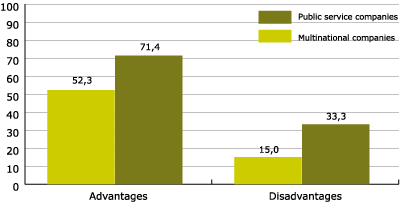
3.2 Main advantages adduced
68% of the
multinationals stated that it enhanced
communication. Resumed under this heading were aspects such as “better attention
(to customers)”, “giving a good image”, “giving better service”,
“prestigious image” and “image of "closeness" (accessibility,
etc.). The second advantage cited (13%) was “better relationship with Catalan
speakers”
Figure
4. Advantages in using Catalan in the multinationals
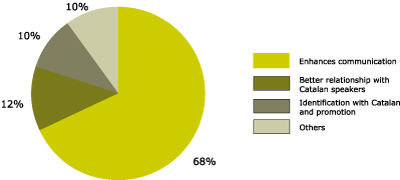
In the case of
public service companies also, 57% of the companies in the sample state that the main and
most obvious advantage is that Catalan enhances communication. The second advantage cited
(19%) is “better fit with the cultural and language situation”.
Figure
5. Advantages in using Catalan in public service companies
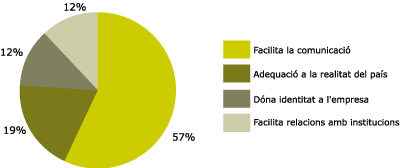
3.3 Main disadvantages adduced
In the case of the
multinationals and the disadvantages they adduce, we find no single predominant argument.
Difficulty in relating with customers (28%) and “the Spanish-speaking market” (19%) and increased costs (17%) are
the three perceived drawbacks that are most frequent of the minority (less than 50%-level)
responses obtained.
Figure 6.
Disadvantages in using Catalan in multinational companies
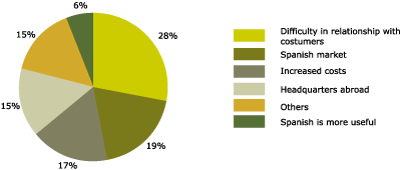
For the public
services companies the main drawback is the difference in economic costs involved in using
Catalan, and the second most-stated drawback that we find is difficulty in communicating
with non-Catalan speakers in Catalonia and with users outside Catalonia.
Figure
7. Disadvantages in using Catalan in public service companies
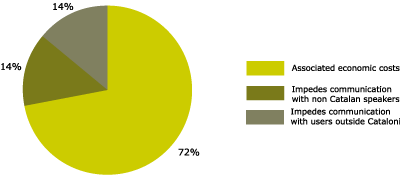
3.4 The intention of increasing use
of Catalan
These perceived
advantages and disadvantages can lead companies to increase or not increase the use of the
Catalan language. 15% of the multinationals intend to increase use, as against 62%of
public service companies. So here there is a clear difference, owing above all to the
territory covered by the two types of company.
Figure
8. The intention of increasing use of catalan in the company
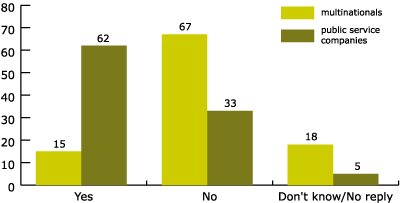
4. Interest in language services
4.1
Rating of language services
On a scale of 0 to
10, the three language services most highly rated by both the multinationals and the
public service companies are software in Catalan, vocabularies and terminology. These
three services are characterised by their comprehensible material and easy and rapid
application by companies. The other services are less well known and probably demand
greater commitment, and are usually more costly to apply. A fact to note here is that the
most highly rated services for both types of company are in the area where there is lowest
use, as we have seen: in Information Technology / software. That is good news, interesting
to the services that are helping to increase use where this is low.
Figure 9. Interest in the
language services offered
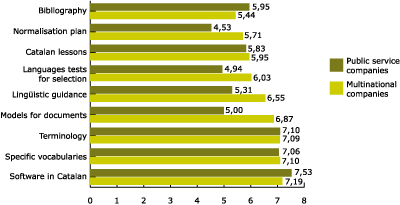
|
